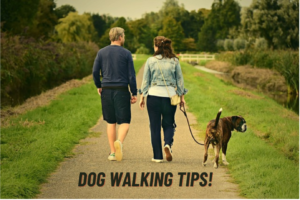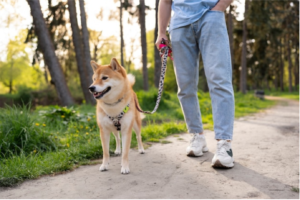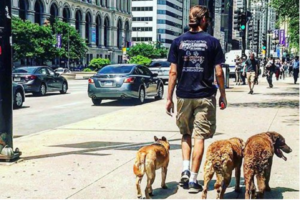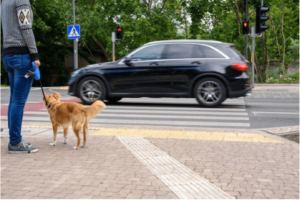7 Surprising Dog Walking Tips You’ve Never Heard Before!

Are you tired of the same old dog walk routine? Do you find yourself struggling to control your doggy on busy streets or wondering if you’re providing enough mental stimulation?
Well, Get ready to discover how to optimize your dog’s exercise routine, perfect off-leash training, and even tailor walks for mental stimulation. Whether you’re a seasoned dog owner or a new pup parent, these tips will help you avoid common pitfalls, keep your dog safe, and make every walk an adventure. So, grab that leash and let’s dive into the world of extraordinary dog walking!
Master the Art of Leash Control

A. Allow sufficient slack for exploration
Proper leash control is crucial for a safe and enjoyable walk. Allow your dog some freedom to explore by giving sufficient slack in the leash. However, be prepared to shorten it in crowded areas for better control. Train your dog to respond to commands like “leave it” to prevent unwanted interactions. Use a loose grip on the leash, securing it with your thumb for quick release if needed. This technique offers better communication and stability during walks. With this approach mastered, we’ll next explore how to optimize your dog’s exercise routine for maximum benefit.
Optimize Your Dog’s Exercise Routine

Now that we’ve mastered leash control, let’s optimize your dog’s exercise routine. Understanding breed-specific needs is crucial; active breeds may require 2-3 hours daily, while toy breeds need less. Consider multiple short walks instead of longer runs, especially for senior or overweight dogs. Incorporate mental stimulation through sniffing time, allowing your dog to explore their environment at a leisurely pace. This approach not only provides physical exercise but also enhances your dog’s mental well-being.
A. Understand breed-specific exercise needs
| Breed Type | Exercise Needs |
| Active | 2-3 hours daily |
| Toy | Less intensive |
| Senior | Tailored approach |
B. Consider multiple short walks vs. longer runs
- Short walks: Ideal for senior or overweight dogs
- Longer runs: Suitable for high-energy breeds
- Tailor to your dog’s energy levels and preferences
C. Incorporate mental stimulation through sniffing time
- Allow leisurely exploration
- Enhances mental well-being
- Combines physical and mental exercise
With this optimized routine in mind, we’ll next explore how to perfect off-leash training for even more freedom during walks.
Perfect Off-Leash Training

Now that we’ve optimized your dog’s exercise routine, let’s perfect off-leash training for even more freedom during walks.
A. Ensure reliable recall in various environments
Mastering recall is crucial for off-leash success. Start in quiet areas, gradually introducing distractions. Use high-value treats and make recall a fun game to reinforce the behavior.
B. Use a long line for safety during training
A long line provides control while allowing freedom. It’s essential for transitioning from leash to off-leash and establishing boundaries.
C. Group dogs by temperament for off-leash play
| Temperament | Best Play Group |
| Calm | Other calm dogs |
| Energetic | Active dogs |
| Shy | Gentle, patient dogs |
Proper grouping ensures positive socialization experiences during off-leash activities.
With these off-leash training tips mastered, we’ll next explore how to enhance walk enjoyment with treats.
Enhance Walk Enjoyment with Treats

Now that we’ve covered off-leash training, let’s explore how treats can enhance your dog’s walking experience.
A. Reinforce positive behavior
Use treats strategically to reward good behavior during walks. This reinforces desired actions and strengthens your bond.
B. Strengthen your bond with your dog
| Treat Type | Benefits |
| Food | Quick reward, high-value |
| Verbal | Builds confidence, no calories |
| Toys | Engages play drive, mental stimulation |
C. Use treats strategically during training sessions
Gradually reduce treat frequency as commands are mastered, transitioning to non-food rewards like praise or playtime.
With this approach to Enhance Walk Enjoyment with Treats, you’ll be well-prepared to navigate legal requirements in the next section.
Navigate Legal Requirements

Now that we’ve sweetened walks with treats, let’s ensure you’re following the rules by navigating legal requirements for dog walking. Staying compliant keeps your pup safe and avoids potential fines.
A. Limit group walks to four dogs
Many local laws restrict group walks to four dogs per person for safety and control. Check your area’s regulations to stay within the limit and ensure a manageable walk.
B. Ensure proper identification on dog tags
Always have your dog wear a collar with up-to-date tags, including their name and your contact info. This is often a legal requirement and helps reunite you if your pup gets lost.
C. Be aware of restricted areas for dogs
| Restricted Area Tips |
| Parks: Check for “no dogs” signs |
| Beaches: Follow seasonal rules |
| Public spaces: Respect leash laws |
Know where dogs are allowed or banned to avoid trouble and keep everyone safe.
With these legal tips in mind, let’s move on to prioritizing safety near roads for worry-free walks.
Prioritize Safety Near Roads

Now that you’re aware of legal requirements, let’s focus on keeping your dog safe near roads. These tips will help you navigate traffic-heavy areas with confidence.
A. Keep dogs on leash near traffic
Always use a leash in high-traffic zones to prevent your dog from darting into the road. A sturdy, short leash gives you better control in these risky areas.
B. Understand legal obligations under the Road Traffic Act
The Road Traffic Act often requires dogs to be under control near roads. Familiarize yourself with local laws to avoid fines and ensure your pup’s safety.
C. Train dogs to stay close in high-risk areas
Teach your dog commands like “stay” or “heel” to keep them near you in busy spots. Practice in low-risk areas first, using treats to reinforce good behavior.
With road safety covered, let’s explore how to tailor walks for mental stimulation to make every outing even more enriching.
Tailor Walks for Mental Stimulation

Now that we’ve prioritized safety near roads, let’s make walks more exciting by tailoring them for mental stimulation. These strategies will keep your dog’s mind as active as their body.
A. Allow for exploratory sniffing time
Many local laws restrict group walks to four dogs per person for safety and control. Check your area’s regulations to stay within the limit and ensure a manageable walk.
B. Vary walking routes and environments
| Route Variation Benefits |
| New smells: Stimulates curiosity |
| Different sights: Keeps walks exciting |
| Fresh challenges: Boosts problem-solving |
Switch up your routes to prevent boredom and spark your dog’s interest.
C. Balance physical exercise with mental engagement
Teach your dog commands like “stay” or “heel” to keep them near you in busy spots. Practice in low-risk areas first, using treats to reinforce good behavior.
With road safety covered, let’s explore how to tailor walks for mental stimulation to make every outing even more enriching.
Conclusion

There you have it—seven surprising tips to take your dog walks from ordinary to extraordinary! From mastering leash control and optimizing exercise to perfecting off-leash training, using treats, navigating legal rules, staying safe near roads, and adding mental stimulation, you’re now equipped to make every stroll a joy for you and your pup. These strategies will keep your furry friend happy, healthy, and engaged while strengthening your bond.
Grab that leash and start trying these tips on your next walk. Have a favorite tip or a fun dog walking story to share? Share it with us—we’d love to hear how these ideas are working for you and your four-legged pal!

